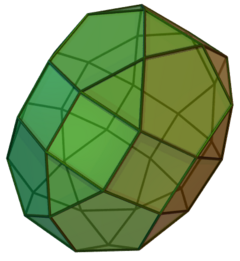Elongated pentagonal orthobirotunda: Difference between revisions
Appearance
Content deleted Content added
No edit summary |
AndrewKepert (talk | contribs) m convert to infobox, trial of navigation |
||
| Line 20: | Line 20: | ||
|bgcolor=#e7dcc3|Properties||convex |
|bgcolor=#e7dcc3|Properties||convex |
||
|} |
|} |
||
{{Infobox_Polyhedron | |
|||
Image_File=Elongated pentagonal gyrobirotunda.png | |
|||
Polyhedron_Type=[[Johnson solid|Johnson]]<br>[[elongated pentagonal gyrocupolarotunda|J<sub>41</sub>]] - '''J<sub>42</sub>''' - [[elongated pentagonal gyrobirotunda|J<sub>43</sub>]] | |
|||
Face_List=20 [[triangle]]s<br>10 [[square]]s<br>12 [[pentagon]]s | |
|||
Edge_Count=80 | |
|||
Vertex_Count=40 | |
|||
Symmetry_Group=D<sub>5h</sub>| |
|||
Vertex_List=20 of 3.4<sup>2</sup>.5<br>20 of 3.5.3.5| |
|||
Dual=-| |
|||
Property_List=[[convex]]}} |
|||
Revision as of 03:20, 23 November 2004
| Elongated pentagonal orthobirotunda | |
|---|---|

| |
| Type | Johnson |
| Faces | 20 triangles 10 squares 12 pentagons |
| Edges | 80 |
| Vertices | 40 |
| Vertex configuration | - |
| Symmetry group | - |
| Dual polyhedron | - |
| Properties | convex |
| Elongated pentagonal orthobirotunda | |
|---|---|
 | |
| Type | Johnson J41 - J42 - J43 |
| Faces | 20 triangles 10 squares 12 pentagons |
| Edges | 80 |
| Vertices | 40 |
| Vertex configuration | 20 of 3.42.5 20 of 3.5.3.5 |
| Symmetry group | D5h |
| Dual polyhedron | - |
| Properties | convex |
In geometry, the Elongated pentagonal orthobirotunda is one of the
Johnson solids (J42). It is a similar construction to another Johnson solid, the Elongated pentagonal gyrobirotunda. The difference is a twist of 36 degrees between the two pentagonal rotundae.
The 92 Johnson solids were named and described by Norman Johnson in 1966.
